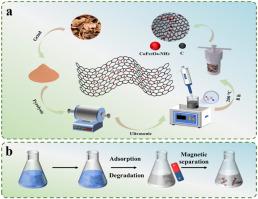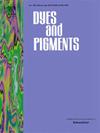CoFe2O4-NH2@DJB2-900活化过一硫酸盐增强抗生素的吸附和催化降解:实验和机理研究
IF 4.1
3区 工程技术
Q2 CHEMISTRY, APPLIED
引用次数: 0
摘要
近年来,随着抗生素在临床上的广泛应用,大量残留抗生素被排入水生环境,对人类健康造成了极大威胁。本文通过将从菊芋(DJ)中提取的生物炭与磁性材料 CoFe2O4-NH2 (CFN)结合,制备了可回收磁性催化剂 CoFe2O4-NH2@DJB2-900(CFN@DJB2-900)。这种催化剂不仅能有效激活过一硫酸盐(PMS)降解左氧氟沙星(LEF),还能实现与基质的快速分离。四次循环后,左氧氟沙星的去除率仍能保持在 83.91%。淬灭实验和电子顺磁共振(EPR)分析表明,左氧氟沙星在CFN@DJB2-900/PMS体系中通过脱氟、脱哌嗪基、脱甲基和开环作用,借助O2∙-、1O2和电子传递实现降解。在 10 分钟内,LEF 去除率达到 94.32%。此外,该材料还具有广泛的适用性、良好的抗干扰能力和可重复使用性。因此,本研究为制备高效降解左氧氟沙星的活化剂 CFN@DJB2-900 提供了一种简单可行的策略。本文章由计算机程序翻译,如有差异,请以英文原文为准。

Enhanced adsorption and catalytic degradation of antibiotics by CoFe2O4–NH2@DJB2-900 activated peroxymonosulfate: An experimental and mechanistic investigation
In recent years, with the widespread use of antibiotics in clinical, a large number of residual antibiotics have been discharged into aquatic environments, posing a substantial threat to human well-being. In this paper, the recyclable magnetic catalyst CoFe2O4–NH2@DJB2-900 (CFN@DJB2-900) was prepared by combining biochar derived from diaphragma juglans (DJ) with magnetic material CoFe2O4–NH2 (CFN). This catalyst could not only effectively activate peroxymonosulfate (PMS) to degrade levofloxacin (LEF), but also realize rapid separation from the matrix. After four cycles, the LEF removal rate could still maintain at 83.91 %. The quenching experiments and electron paramagnetic resonance (EPR) analysis demonstrated that LEF was degraded by defluorination, depiperazinylation, demethylation and ring opening in CFN@DJB2-900/PMS system with the help of O2∙-, 1O2 and electron transfer. The LEF removal rate of 94.32 % was achieved within 10 min. Moreover, the material exhibited wide applicability, good anti-interference ability and reusability. Therefore, this study provided a simple and feasible strategy to prepare an efficient activator CFN@DJB2-900 for the degradation of levofloxacin.
求助全文
通过发布文献求助,成功后即可免费获取论文全文。
去求助
来源期刊

Dyes and Pigments
工程技术-材料科学:纺织
CiteScore
8.20
自引率
13.30%
发文量
933
审稿时长
33 days
期刊介绍:
Dyes and Pigments covers the scientific and technical aspects of the chemistry and physics of dyes, pigments and their intermediates. Emphasis is placed on the properties of the colouring matters themselves rather than on their applications or the system in which they may be applied.
Thus the journal accepts research and review papers on the synthesis of dyes, pigments and intermediates, their physical or chemical properties, e.g. spectroscopic, surface, solution or solid state characteristics, the physical aspects of their preparation, e.g. precipitation, nucleation and growth, crystal formation, liquid crystalline characteristics, their photochemical, ecological or biological properties and the relationship between colour and chemical constitution. However, papers are considered which deal with the more fundamental aspects of colourant application and of the interactions of colourants with substrates or media.
The journal will interest a wide variety of workers in a range of disciplines whose work involves dyes, pigments and their intermediates, and provides a platform for investigators with common interests but diverse fields of activity such as cosmetics, reprographics, dye and pigment synthesis, medical research, polymers, etc.
 求助内容:
求助内容: 应助结果提醒方式:
应助结果提醒方式:


